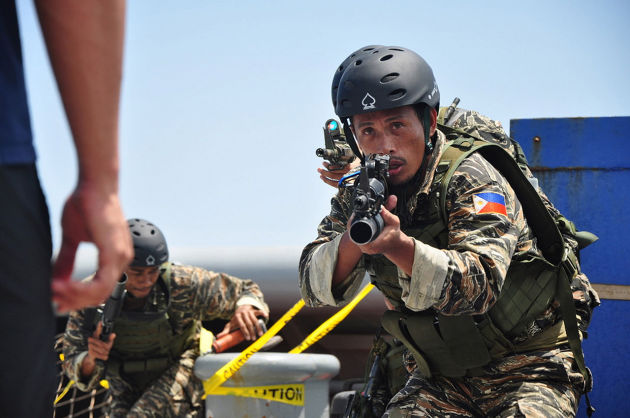Late June DefenseNews reported that U.S. Navy SEALs had provided training to Filipino forces on the use of smaller unmanned aerial surveillance vehicles known as Puma’s. Although the instruction was considered a component of routine exercises conducted annually between the two countries the training the SEALs provided seemed to focus on countering the country’s continual insurgent threat.
Less than a month prior to commencing naval exercises Philippine troops clashed with militant fighters from Abu Sayyaf, an Islamist militant group with ties to al-Qaeda. The battle in the southern province of Sulu lasted only an hour but the results were deadly 7 of the country’s marines were killed along with 5 insurgents. Is this a signal of what lay ahead for Naval Special Warfare, transitioning from training troops to fighting al-Qaeda in the P.I., or is the greater threat to Manila coming from its northwestern shores?
It’s no secret that Beijing has been making claims to more and more of the South China Sea while increasingly intruding on Vietnamese and Filipino waters. Anxiety of such expansion has led Manila to reach out to America for support. “At this point in time, we cannot stand alone. We need allies. If we don’t do this, we will be bullied by bigger powers, and that is what is happening now: There is China, sitting on our territory,” said Philippine Defense Secretary Voltaire Gazmin. He was speaking in reference to President Benigno Aquino’s recent statements on allowing the United States and possibly Japan greater access to their skeleton military bases located in the P.I..
Decades earlier the United States had thousands of troops stationed in the Philippines but in 1994 the U.S. was forced to discontinue use of some of it’s largest bases in the region, Clark Air Base and Subic Naval Base. Despite the withdrawal a portion of each of base has remained open to service U.S. military aircraft and warships during short-term exercises. The question is will Naval Special Warfare be one of the components returning to Subic Bay.
The United States Special Operations Command has been steadily rotating SOF operators through the southern portion of the country since early 2002 in an effort to quell Abu Sayyaf and other al-Qaeda aligned forces. It stands to reason with President Aquino’s current efforts in allowing the U.S. back into the Philippines without circumventing the country’s constitutional ban on “permanent foreign bases” that it’s a good possibility U.S. Navy SEALs might return. Having the SEALs back in the P.I. will not only assist in countering China’s encroachment on their waters but also allow for a more significant response with the country’s battle against homegrown and invading terrorists.
Read more at Defense News.


Leave a Reply
You must be logged in to post a comment.